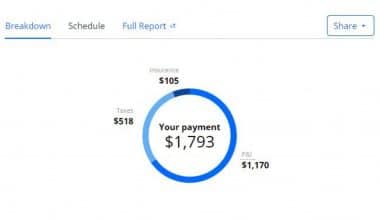When it comes to investing, the first thing you’ll need is money. By developing a monthly household budget, you can find out where all of your money goes, allowing you to set away money for your goals, such as retirement savings.
A written plan is essential. It might be a simple monthly budget—just scribbling numbers on paper—or it can be computerized with a spreadsheet or software. Monthly budgeting can help you keep track of your spending and set savings goals. Make a monthly budget by following these steps.
What is a Monthly Budget?
A monthly budget is a plan for spending your money each month. Monthly budgets are popular since many recurring expenses occur on a monthly basis, such as rent, utilities, credit card payments, and other loan payments.
Your budget should ideally include spending less than you make each month, leaving you with money to save. Spending savings or borrowing money to make ends meet involves budgeting for more than you earn in a month.
Instead of assuming you have enough money to meet important needs or emergencies, a budget should make it easier to plan for them in advance. Budgets can also make you more conscious of how you spend money, making it simpler to prioritize spending on what is important to you while lowering spending on what isn’t.
5 Steps to Make a Monthly Budget
#1. Determine your monthly revenue.
The first step in creating a monthly budget is figuring out how much money you make each month. This determines how much you can spend (and save) each month.
Look for dependable sources of revenue when determining your monthly income. You should include your day job’s compensation, but you should generally eliminate less reliable sources of income, such as selling old items you no longer need.
Make sure your income is calculated using your net income, commonly known as your “take-home pay.” This is the money remaining after taxes and payroll deductions.
#2. Track your spending for a month or two.
Tracking your actual spending over a few months is one of the greatest methods to get a feel of how much you should budget for. Some programs that link to your bank account can help you track your spending, or you can track it manually by storing receipts and totaling up expenses yourself.
As you track your expenditures, you may discover that you spend more or less than expected in several categories. This is significant because it serves as a nice transition into the following step in the process.
Remember to budget for expenses that may arise annually rather than monthly. Property taxes, car insurance payments, doctor or veterinary appointments, and vacation costs should all be considered.
#3. Consider your financial priorities.
After you’ve spent some time documenting your spending, take a look at your spending history and how it relates to your financial priorities.
Everyone has unavoidable expenses such as rent, food, and bills. However, if you don’t make an effort to keep track of your expenditures, it’s simple to spend far more than you expected on non-essentials. For example, you might discover that you’re spending hundreds of dollars each month on takeout or that you have a slew of monthly subscriptions that you rarely use.
Making a budget does not imply limiting your spending to simply the necessities. It’s more about allocating your money in a way that makes sense for you. Once you’ve determined how much you’re spending on particular items, you may want to experiment with changing your spending patterns in order to enhance your savings or devote more money to enjoyable hobbies or pastimes.
#4. Create a budget
To create a budget, make a list of the various line items that correspond to each spending category. It’s a good idea to pay yourself first. Savings, whether for an emergency fund, a new car, a down payment on a home, or other objectives, should be one of the first things you include in your budget. Take Warren Buffett’s advice: “Do not save what is left after spending, but spend what is left after saving.”
Next, examine your spending habits to see how they correspond to your priorities. If your actual spending matches your goals, you can use your spending history as a reference for your budget. If you want to entirely change your spending patterns, you should start from scratch with your budget.
The 50/30/20 budget guideline is a classic budgeting rule of thumb. According to the rule, you should spend 50% of your money on necessities, 30% on wants, and 20% on savings. It is entirely up to you how you distribute your expenditures within these areas.
There are no hard and fast rules when it comes to budgeting, as long as you spend your money in a way that is fulfilling and contributes to your financial goals. The most crucial rule to follow is to spend less than you earn each month. Even if you can’t save 20% of your salary, attempting to save as much as possible is a smart financial habit to develop.
#5. Monitor your expenditures and adjust your budget as needed.
Budgets are dynamic documents. They are not fixed in stone. Following the creation of your budget, you should continue to track your spending and attempt to adhere to your spending plan.
However, as time passes, your priorities and your circumstances may change. For example, you may take out a new debt that you must repay, or you may receive a salary raise that allows you additional spending flexibility. Examine your budget every six months or at least once a year to assess how well you’re sticking to it. You can adjust your budget to reflect changes in your expenditure and income.
How To Make a Monthly Budget Example
Let’s think about how someone may make a budget if they had a $4,000 net income each month using the techniques indicated above. Remember that net income is the amount of money available for budgeting after taxes and deductions are deducted. Earnings from full-time employment, as well as any passive income or side activities, might be included in net income.
It can be useful to prioritize each line item. This budget prioritizes savings first, then necessities or basics, and then wants or non-essentials.
Following the creation of the budget, you should track your spending to evaluate how real expenses compare to expected expenses. The budget should then be adjusted to make up for any variances.
| Category | Line item | Amount per month |
| Savings | Emergency fund | $300 |
| Vacation fund | $200 | |
| Retirement | $200 | |
| Total | $700 | |
| Needs | Rent | $1,200 |
| Transportation | $400 | |
| Electricity | $60 | |
| Gas/oil | $30 | |
| Phone | $60 | |
| Internet | $40 | |
| Groceries | $270 | |
| Personal care/hygiene | $40 | |
| Credit card | $100 | |
| Total | $2,200 | |
| Wants | Streaming subscriptions | $70 |
| Dining out/ food delivery | $250 | |
| Apparel | $100 | |
| Nightlife | $100 | |
| Movies/theater | $50 | |
| Gifts | $100 | |
| Miscellaneous spending | $430 | |
| Total | $1,100 | |
| Total for all categories | $4,000 |
Tools For Making a Monthly Budget
#1. Budget apps:
There are various apps that can help with some of the tedious efforts of sticking to a budget. Budgeting programs like Mint and EveryDollar include digital tools that can manage your spending, track your savings objectives, and even provide insight into where you may save money on specific costs.
#2. Savings accounts:
Savings are a crucial part of any budget, and you’ll need a savings account to keep those dollars in. The interest rate and monthly fees are two things to check for in a savings account. If you do not maintain a minimum amount, the account may charge you a fee, so make sure the minimum deposit requirements are reasonable for your financial circumstances.
#3. Checking accounts:
A savings account is where you keep the money for various savings objectives or emergencies, whereas a checking account is where you keep the money for daily expenditures. You can keep track of your spending by reviewing the transaction history of your checking account. If you want to establish a new account, you might be able to benefit from an account bonus.
#4. Budget calculator:
Bankrate’s home budget calculator calculates your net income after you account for each cost category. It also advises budget changes to help you save more money.
#5. Microsoft Office template:
For individuals who prefer manual budgeting to digital services, Microsoft Office’s budget template is a terrific alternative, and it’s free with Microsoft 365. It outlines the major expenditure categories for a single household; simply fill in the cells with the amount of each expense.
What are the Four Different Types of Budgeting?
- Incremental Budgeting
- Activity-based budgeting.
- Value proposition budgeting.
- Zero-based budgeting.
How Do You Make a 50-30-20 Budget?
According to the rule, you should spend up to 50% of your after-tax income on necessities and commitments that you must have or fulfill. The remaining half should be divided as follows: 20% for savings and debt payments, and 30% for whatever else you desire.
How Can I Calculate My Monthly Budget?
How does one make a budget spreadsheet? Begin by calculating your take-home (net) income, then assess your present spending. Finally, follow the 50/30/20 rule: allocate 50% of your income to needs, 30% to wants, and 20% to savings and debt reduction.
Understand your spending tendencies.
Knowing your spending habits can assist you in developing a more realistic budget to help you achieve your investing objectives. Set an unreasonable monthly budget of $20 for necessities such as groceries, for example.
You can find some natural averages that work by tracking your spending habits over time. Tracking your costs over time allows you to establish realistic averages for both necessary goods such as rent or utility bills and discretionary items such as dining out or date evenings. You want to budget for enjoyment without jeopardizing your ability to fulfill crucial goals.
Everyone’s budget should include a line item for fun, even if it’s lower than you’d want due to budgetary constraints. But if you don’t include it, you’ll break your budget and end up regretting it. With a realistic monthly budget that balances necessities and wants, you’ll understand where all your money goes and where you might be able to free up money for important goals you want to pursue, such as a vacation or a down payment on a home.
Budgets will vary when large life events occur, and even minor occurrences may cause them to shift. Pay hikes, windfalls, or short-term losses make it worthwhile to check in on a regular basis. At this point, you should review your budget and consider devoting extra funds to debt repayment or retirement savings. Alternatively, you may need to reduce certain discretionary expenses to get through a setback.
Similarly, new goals will inevitably emerge, and you’ll need to re-evaluate your budget and even change your spending and saving to pursue them.
The most important aspect of budgeting is understanding the relationship between income and expenses and how they affect your savings goals.
Conclusion
As prices continue to rise, it is more important than ever to keep track of where your money is going. Making a budget is an efficient approach to keeping track of your spending, developing a better understanding of your financial patterns, and encouraging saving.
Track your expenditures for a month before making a monthly budget, noting necessary expenses, superfluous expenses, and areas for savings. You’ll compare your expenses to your income, with the goal of spending less than you make. Consider utilizing budgeting software or a calculator to create your budget to save time and effort.
- HOW TO MAKE MONEY WORK FOR YOU: Easy Ways to Make Your Money Work for You
- FAMILY BUDGET: How To Make One
- PERSONAL FINANCIAL MANAGEMENT: Guide to Personal Financial Management
- BUSINESS BUDGETING TOOLS: All You Need To Know, Types, and Free Budgeting Tools
- BUDGET MANAGEMENT TOOLS: Definition, and Best Budget Management Tools






